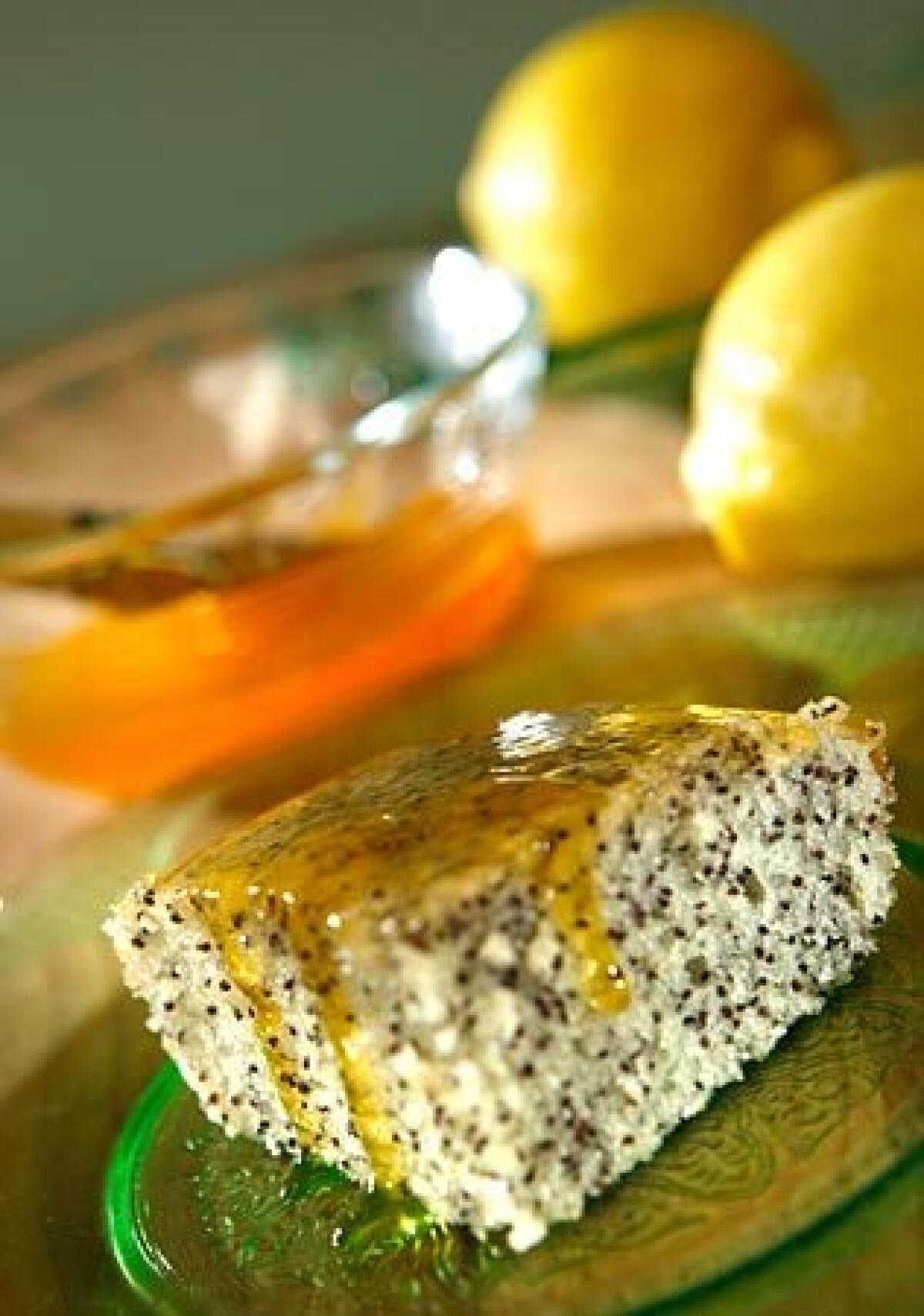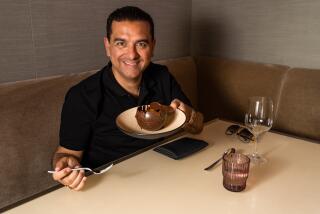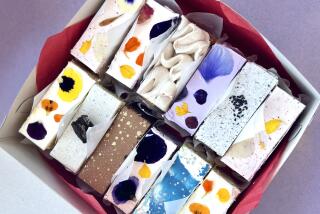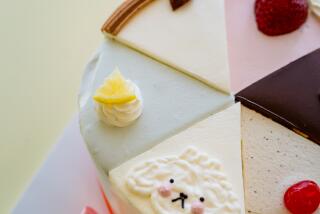Mad for crazy cake

- Share via
During a recent visit with my sister and her family, we were invited to share Shabbat dinner with our cousins. My sister volunteered to bring dessert. Because the meal would be kosher, with chicken the main course, that meant making something parve -- without any dairy ingredients -- in keeping with the Jewish dietary restriction not to mix meat and milk.
Normally in this circumstance I would bake a nondairy classic like mandelbrot. But my sister flipped through cookbooks and stumbled on a recipe for something called Crazy Chocolate Cake.
“This can’t be right,” I commented, after wondering about the ingredients. Or, rather, the missing ingredients. Not only was there no butter, there also were no eggs. Oh, and no mixer was required either.
Time was running out, my nephews needed to be picked up, so we decided to go for it. In fact, we went for it big-time; there would be a crowd at dinner so we doubled the recipe.
The preparation couldn’t have been simpler. Into an ungreased pan we sifted a combination of flour, cocoa powder and baking soda. Three round indentations then were formed in the dry mixture. Into one went vanilla, in the second a small amount of vinegar and in the third canola oil.
The final step was to pour water over the whole shebang and stir until it morphed into a smooth batter.
I had serious doubts about this endeavor, but these misgivings started to dissipate as good smells filled the kitchen. And when the cake emerged from the oven, it certainly looked appealing. The recipe suggested brushing on a jam glaze, but we had run out of time. We packed up the cake and got in the car. Before serving, the boys took turns sifting powdered sugar on top.
The cake was surprisingly rich, moist and flavorful, and was a nice accompaniment to a fruit platter. One of the other dinner guests commented that this mystery was simply crazy cake, also called wacky cake, and has been around for years.
A sweet history
Curious, I called my mother-in-law and asked her if she had ever heard of this sweet treat. She got really excited. It turns out her own mother had made crazy cake so often, my mother-in-law thought she must have invented the recipe. It wasn’t until later in life that she learned that crazy cake was popular in many homes. My mother-in-law speculated that “it came from one original recipe, and everybody added their own bit.”
Her theory is probably correct, judging by the many variations of crazy cake that exist in old cookbooks and on the Web. Some call for baking soda, some for baking powder, some for both. The liquid ranges from cold water to boiling water to room temperature coffee. A wide array of add-ins and frostings give the cake unusual twists and turns.
“I call them folk art cakes,” says Sarah Phillips, founder of the website Baking911 ( www.baking911.com). “They’re ingrained in our society. They’re easy to make, delicious, you make them in one bowl or two, they get passed down through the centuries.”
While some cookbooks place the origin of crazy cake in the 1970s, food historian Lynne Olver, a reference librarian who created the website Food Timeline ( www.foodtimeline.org), says that the cake existed as early as World War II, when rationing forced bakers to deal with shortages of key ingredients like eggs and butter.
“I bet you could push that recipe back even further,” says Olver, adding that though the cake may have been born from necessity, by the 1970s women’s magazines played a role in making crazy cake seem modern and trendy: “You were not just making a cake, you were conducting an experiment.”
Olver speculates that the recipe was probably discovered by accident by a creative home cook: “Using vinegar in baking was not uncommon in the late 19th century. Presumably, the method (all mixed in one pan) was the byproduct of necessity. Smart cooks have been doing this for thousands of years.”
I tried about a half dozen crazy cake recipes and was surprised that I never tasted even a hint of vinegar. But food scientist Shirley Corriher, author of “CookWise” and “BakeWise,” says her husband has “fragile” taste buds and could indeed detect the vinegar. She discovered that she could reduce this ingredient without disturbing the cake’s texture.
Cake chemistry
The key challenge of crazy cake is getting the cake to hold together. Corriher explains that in a normal recipe, eggs and flour supply the protein required to set and hold the cake. Without eggs, the flour is responsible for giving the cake its form and texture. For crazy cake, she says it’s essential to use a high-protein all-purpose unbleached flour such as King Arthur.
“You need a flour with all the protein you can get,” Corriher says. “When you add water to flour and stir, the proteins in the flour grab the water and each other and make these springy elastic sheets of gluten. . . . With an eggless cake, you don’t have much to hold the cake together. So you’ve got to give those glutens every advantage to get together. The reason for the vinegar in the cake is to do this. An acidic batter helps the proteins to set faster. And the other thing that helps is the ca-razy method of putting it together.”
Forming the three holes, then pouring water over all and stirring allows the oil to float on top of the liquid, letting the water get directly to the flour, so it can make some gluten.
In her recipe, Corriher uses more cocoa powder than in other versions, for a deeper chocolate flavor. And she calls for extra oil to create a more moist cake. She recommends using baking powder because it is more dependable than baking soda. Corriher also cautions not to use Dutch process cocoa, because its alkalinity may interfere with the setting of the cake.
There are a lot of variations in the many recipes for crazy cake, but nearly all of them call for combinations of cocoa and vanilla, which helps explain the enduring popularity of this dessert.
“People love them because they’re easy, and anybody can make them,” says Baking 911’s Phillips. “They’re no fail. What could be better? And they use everyday ingredients. People really like vanilla and chocolate. Those are the No. 1 and 2 flavors.”
I wondered whether it would be possible to create a nonchocolate crazy cake, substituting poppy seeds for the cocoa. And as long as we were going that route, how about lemon juice instead of the vinegar?
Leaving out the vinegar turned out to be a mistake, because lemon juice alone is not acidic enough.
Food scientist Harold McGee explained in an e-mail that the acidity is necessary to react with the baking soda and produce the air bubbles that leaven the cake, making it lighter. Hot water speeds the reaction and if the water is hot enough, it will also thicken the batter, which would help it retain the bubbles and make the cake lighter still. But he also suggested that substituting baking powder, which leavens both with acidity and the heat from baking, would make an even lighter cake.
McGee was right, I got much better results using baking powder. And when I used a combination of fresh lemon juice and cider vinegar, the texture of the cake was just right.
“As an eggless cake, [Crazy Cake] is incredibly tender and wonderful,” Corriher says. “Many a mother has cranked out a cake in minutes for her hungry children using the crazy cake basics.”
More to Read
Eat your way across L.A.
Get our weekly Tasting Notes newsletter for reviews, news and more.
You may occasionally receive promotional content from the Los Angeles Times.










